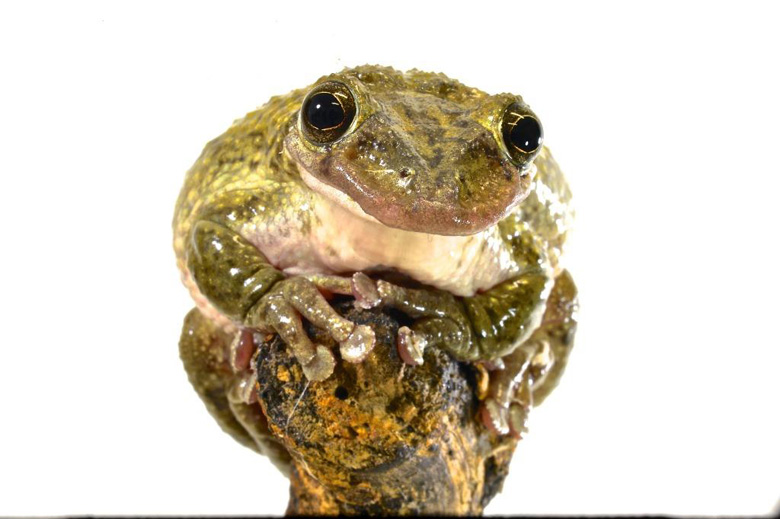- A frog species with a toxic venom injection defense mechanism has been described in the semi-arid northeastern region of Brazil.
- Carlos Jared, a Brazilian scientist at the Butantan Institute made the discovery by chance after having his hand head-butted by a tree frog.
- One distinctive and interesting feature of the morphology of the Greening’s frog is the similarity of its skull to that of a spiny cactus plant.
A frog species capable of defending itself by injecting toxic venom into a predator has been described in the semi-arid northeastern region of Brazil — a discovery made by accident when Carlos Jared, a Brazilian scientist at the Butantan Institute was collecting Greening’s frogs (Corythomantis greening), a tree frog described by British zoologist George Boulenger over a century ago, but whose biology and natural history remained unstudied until now.
Jared made the find quite by chance, after having his hand head-butted by a tree frog, then feeling “pain in his arm that lasted for about five hours.”
The scientist began studying similar casque-headed frogs in 1987 when first visiting the Brazilian Caatinga — a very dry biome that occupies 800,000 square kilometers (308,880 square miles).
In preliminary research, Jared reviewed past scientific papers on the Greening’s frog and learned that zoologists had already described its “casque” — the helmet-shaped bony and spiny structure of its head. “My initial intention was to study the adaptive tactics of amphibians in an extremely dry environment where they normally shouldn’t exist,” Jared said, “so I [recently] decided to go to the Caatinga [again] to collect specimens of these interesting animals.”

The painful sensation he felt in his arm immediately made him suspect a connection with the head-butting behavior he had observed when collecting the frog. Jared’s suspicion was confirmed when tissue sections were examined revealing poison glands around the base of spines present in the frog’s helmet-shaped head. One distinctive and interesting feature of the morphology of the Greening’s frog is the similarity of its skull to that of a spiny cactus plant.
The skin that covers the head is dense with tiny spines that protrude from the skull, but only the tips of the spines can be seen, as the lower shafts remain hidden beneath the skin. Although many amphibians (frogs and toads in particular) secrete poisonous substances onto their skin to deter predators, they are not considered venomous because they do not possess the ability to directly inject poison into another animal. This injection ability makes Greening’s frog nearly unique. When in danger, the species flexes its head, and head-butts its enemies, rubbing and jabbing the killer spines into the body of the would-be predator.

A similar bony skull embedded with spines is found in Bruno’s Casque-headed frog (Aparasphenodon brunoi), a related tree frog that inhabits the Atlantic rainforest of Brazil. Jared and his colleagues have calculated the venom toxicity of Bruno’s frog to be 25 times more potent than that of Brazilian pit viper snakes — meaning it is deadly to humans. Although the team is still studying the Greening’s frog, their work shows that A. brunoi has higher venom toxicity than C. greeningi.

The researchers have also conducted experiments that show how Greening’s frog adapts to the extremely dry conditions of the Caatinga. They learned that the species’ head not only serves a defensive purpose, it is also useful for preventing desiccation. The frog stops its body from drying out through a process known as phragmosis, an adaptive behavior that allows it to seal itself within holes in trees or rocks using its body parts.
“In the case of this (Corythomantis greening) species, when the animal exhibits phragmosis, it enters backwards in holes in trees or on rocks and uses its head to close the hole,” Jared said. “The head has thus developed a dual [function of] protection; acting in defense against predators, and also against water loss.”

Citation:
Jared, C., Mailho-Fontana, P. L., Antoniazzi, M. M., Mendes, V. A.; Barbaro, K. C., Rodrigues, M. T., Brodie, E. D. (2015). Venomous Frogs Use Heads as Weapons. Current Biology. doi:10.1016/j.cub.2015.06.061
